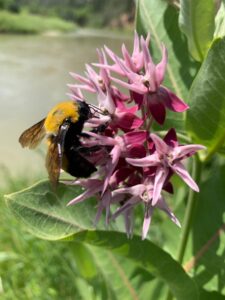
Written by Garrett VeneKlasen, Northern Conservation Director for New Mexico Wild
When I first read a Xerces Society report about the U.S. Department of Agriculture Animal and Plant Health Inspection Service plan to blanket almost 40 square miles in and around the Rio Chama Wilderness Study Area with a highly toxic and possibly carcinogenic pesticide called carbaryl, I initially thought it was a clever joke someone was trying to play on me.
The report reads like an excerpt from Rachel Carson’s sobering 1962 book Silent Spring, which documents the horrific and often permanent impacts pesticides, herbicides and rodenticides have on ecosystems. Surely in this day and age, and after the creation of the Environmental Protection Agency, the sensible federal environmental legislation of the 1960s and 70s, and the passage of regulations limiting the use of toxic pesticides, this simply could not be. Sadly, I was quickly proven wrong.
Indeed, the inspection service was planning, with a target date of June 26, to spray the toxic pesticide to reduce the number of native grasshoppers, which could potentially eat the forage (grass) available to a handful of public land cattle permittees. To be clear, carbaryl not only kills grasshoppers but virtually every other insect it touches. It is especially toxic to aquatic invertebrates. The far-reaching consequences of such reckless action are unfathomable.
So here we were, ironically just past National Pollinator Week, inundated with peer-reviewed studies about the catastrophic decline in the numbers of native pollinators and the myriad birds that rely on them, with a government agency planning to rain death down upon them all.
The process the Animal and Plant Health Inspection Service must follow to carry out such a senseless plan is woefully flawed. In this case, a grazing permittee picked up the phone and said there was an outbreak of grasshoppers on his allotment. The service sent out an inspector to assess the grasshopper population (the science and data here is highly suspect) and determined there were too many grasshoppers.
The National Environmental Policy Act (enacted Jan. 1, 1970) requires agencies to conduct specific biological, hydrological and cultural impact assessments before spraying can take place. The U.S. Fish and Wildlife Service and especially the Taos Bureau of Land Management, which manages the land in question, had to approve the plan before it could take place.
One would think all these assessments, regulations and interagency approvals would take weeks, if not months, to finalize. One would also think the agencies involved would have to issue public notice and perform a public scoping period to ensure impacted stakeholders were informed and had a say in whether the spraying would be allowed to take place.
But there is a loophole in the process allowing the service to fast-track everything to quickly mitigate the threat of a grasshopper “infestation.” Typically and especially in this case, there was a rubber-stamp mentality somewhere in the Fish and Wildlife Service and BLM chain of command that would have allowed the plan to happen last month, had it not been for the circulating Xerces report.
A diverse and massive public outcry quickly evolved. Sen. Martin Heinrich and his remarkable staff immediately engaged all agencies, including the ultimate decision-maker, Field Manager Pamela Mathis at the Taos BLM field office. It was soon determined the service’s NEPA assessment was sloppy and highly flawed.

The combination of pressure by the public and elected officials, community organizing, timely and active media coverage, and Heinrich’s tireless engagement with the agencies ultimately forced BLM to halt the spraying plan. We commend Field Manager Mathis for making the decision to stop the project.
Had the Animal and Plant Health Inspection Service done a better job with its NEPA assessment, halting the pesticide application would have been difficult. Our focus must now shift to ending this dangerous practice and aggressively reforming the agency policies and procedures around environmental review, accountability, transparency and inclusivity. A coalition of local and national nonprofits like ours will be working with Heinrich and other federal, local and state lawmakers to permanently reform the shortsighted and irresponsibly managed insect suppression program. This will not be an easy task. Stay tuned as this issue progresses. We as a community have a moral duty to do so, not just for our sake, but for the long-term health of the land, water and precious creatures whose lives hang in the balance of our actions.
“It is not my contention that chemical insecticides must never be used. I do contend that we have put poisonous and biologically potent chemicals indiscriminately into the hands of persons largely or wholly ignorant of their potential for harm. We have subjected enormous numbers of people to contact with these poisons, without their consent and often without their knowledge.” — Rachel Carson, Silent Spring
– – –
This op-ed was published in the Santa Fe New Mexican on July 8th, 2023.

